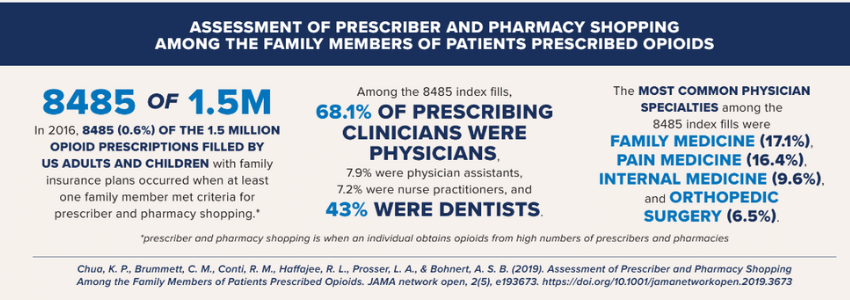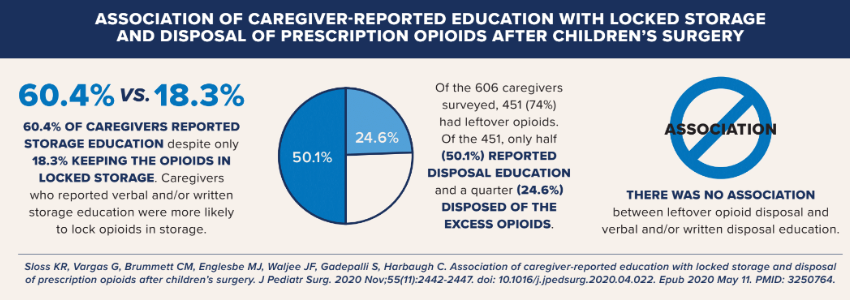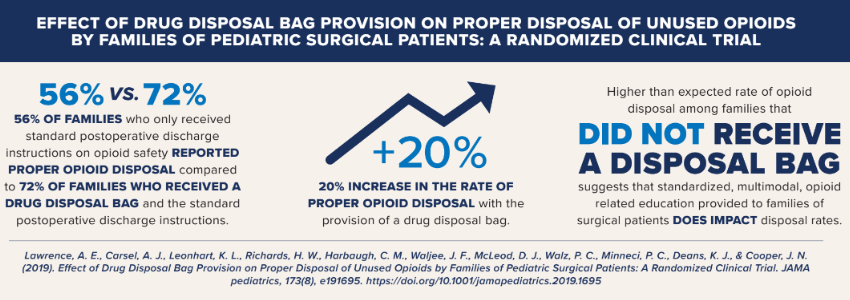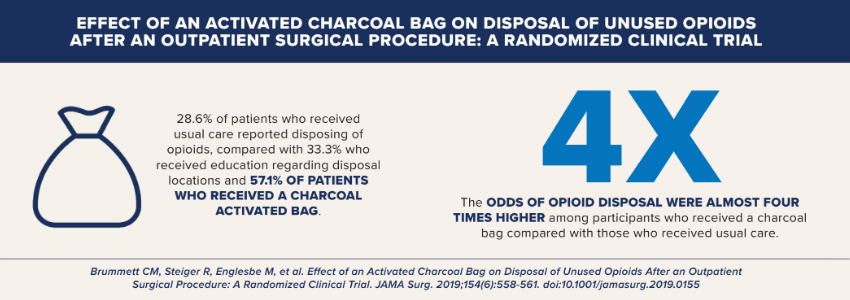Publications
OPEN examines data, clinical practices and strategies to support better pain management, opioid stewardship, policy, treatment and care.
Assessment of Prescriber and Pharmacy Shopping Among the Family Members of Patients Prescribed Opioids
Chua KP, Brummett CM, Conti RM, Haffajee RL, Prosser LA, Bohnert ASB. Assessment of Prescriber and Pharmacy Shopping Among the Family Members of Patients Prescribed Opioids. JAMA Netw Open. 2019 May 3;2(5):e193673. doi: 10.1001/jamanetworkopen.2019.3673. PMID: 31074819; PMCID: PMC6512276.- In 2016, 8485 (0.6%) of the 1.5 million opioid prescriptions filled by US adults and children with family insurance plans occurred when at least 1 family member met criteria for prescriber and pharmacy shopping. *
- Among the 8485 index fills, 68.1% of prescribing clinicians were physicians, 7.9% were physician assistants, 7.2% were nurse practitioners, and 43% were dentists.
- The most common physician specialties among the 8485 index fills were family medicine (17.1%), pain medicine (16.4%), internal medicine (9.6%), and orthopedic surgery (6.5%)
*prescriber and pharmacy shopping is when an individual obtains opioids from high numbers of prescribers and pharmacies

Association of Caregiver-reported education with locked storage and disposal of Prescription opioids after Children’s surgery
Sloss KR, Vargas G, Brummett CM, et al. Association of caregiver-reported education with locked storage and disposal of prescription opioids after children's surgery. Journal of Pediatric Surgery. 2020 Nov;55(11):2442-2447. DOI: 10.1016/j.jpedsurg.2020.04.022. PMID: 32507640.- 60.4% of caregivers reported storage education despite only 18.3% keeping the opioids in locked storage. Caregivers who reported verbal and/or written storage education were more likely to lock opioids in storage
- Of the 606 caregivers surveyed, 451 (74%) had leftover opioids. Of the 451, only half (50.1%) reported disposal education and a quarter (24.6%) disposed of the excess opioids.
- There was no association between leftover opioid disposal and verbal and/or written disposal education.

Effect of Drug Disposal Bag Provision on Proper Disposal of Unused Opioids by Families of Pediatric Surgical Patients: A Randomized Clinical Trial
Lawrence AE, Carsel AJ, Leonhart KL, et al. Effect of Drug Disposal Bag Provision on Proper Disposal of Unused Opioids by Families of Pediatric Surgical Patients: A Randomized Clinical Trial. JAMA Pediatrics. 2019 Aug;173(8):e191695. DOI: 10.1001/jamapediatrics.2019.1695. PMID: 31233129; PMCID: PMC6593625- 56% of families who only received standard postoperative discharge instructions on opioid safety reported proper opioid disposal compared to 72% of families who received a drug disposal bag and the standard postoperative discharge instructions.
- 20% increase in the rate of proper opioid disposal with the provision of a drug disposal bag.
- Higher than expected rate of opioid disposal among families that did not receive a disposal bag suggests that standardized, multimodal, opioid related education provided to families of surgical patients does impact disposal rates.

Effect of an Activated Charcoal Bag on Disposal of Unused Opioids After an Outpatient Surgical Procedure: A Randomized Clinical Trial
Brummett CM, Steiger R, Englesbe M, et al. Effect of an Activated Charcoal Bag on Disposal of Unused Opioids After an Outpatient Surgical Procedure: A Randomized Clinical Trial. JAMA Surg. 2019;154(6):558-561. doi:10.1001/jamasurg.2019.0155- 6% of patients who received usual care reported disposing of opioids, compared with 33.3% who received education regarding disposal locations and 57.1% of patients who received a charcoal activated bag.
- The odds of opioid disposal were almost four times higher among participants who received a charcoal bag compared with those who received usual care.



